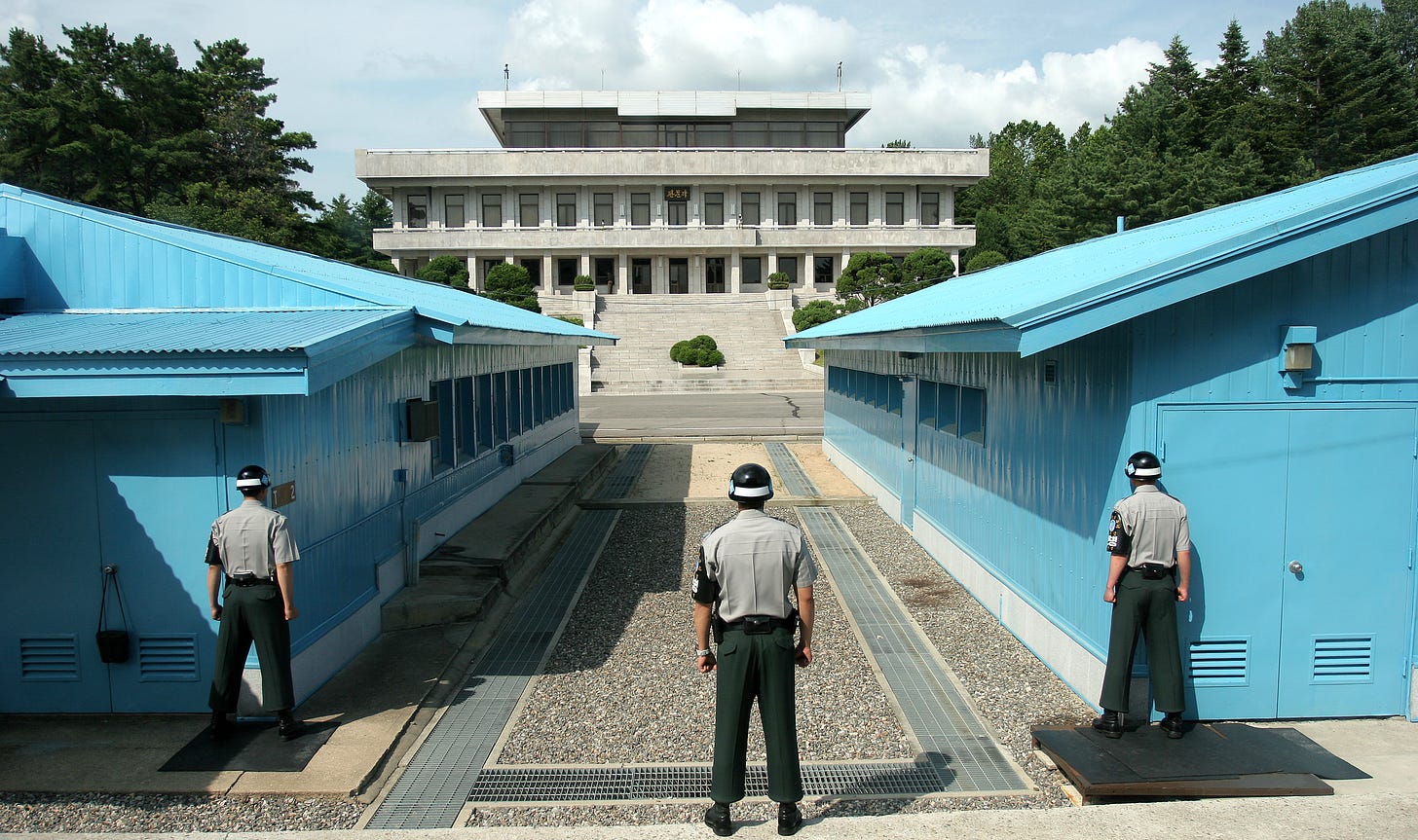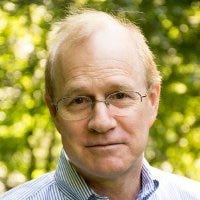ICWA@100: What North Korea sees
Steven Butler on the DMZ in 1984.

Former ICWA Executive Director Steven Butler is a journalist who worked as a foreign correspondent in Asia for nearly 20 years and served as a foreign editor in Knight Ridder’s Washington bureau. He later became Asia program coordinator and senior program consultant at the Committee to Protect Journalists. He holds a PhD in political science from Columbia University. Steven was a fellow in South Korea from 1983 to 1986 and came back in 2007 to run the institute for seven years.
Steven describes a March 1984 trip to Panmunjom, a “truce village” in the demilitarized zone and an important tourist attraction in South Korea. Technically called the Joint Security Area, it straddles the Military Demarcation Line and serves as a designated meeting point between the two Koreas as well as a powerful symbol of the country’s division and America’s involvement.
SEOUL (March 1984) — Korea must be the only country in the world where for just $25 you can tour a war zone. Every weekday at 9:40 a.m. a bus leaves from the downtown tourist hotels and drives north along the Munsan Corridor (the classic invasion route to Seoul), about 29 miles, to Panmunjom, often called “truce village,” which is in the middle of the demilitarized zone.
The guards control the flow of traffic in and out of what is really a historical artifact, a little bit of Korea frozen in time for the past thirty years by a war that never ended. Seoul outstripped the period years ago. Older residents of Seoul talk of a time when the US military base was about the only show in town. The rest of the largely destroyed city, it seemed, lived off the witting or unwitting largesse of Uncle Sam. These days, though, the base is dwarfed by the incredible bustle of the city that has grown up around it. The “NOT FOR SALE” USDA butter and California jug wine that show up in the black market are now a minor footnote to Korea’s industrial dynamism.
But thirty miles to the north it is very different. On July 27, 1953, the American generals commanding United Nations forces and the generals commanding Chinese and North Korean forces agreed to stop shooting at each other. (A South Korean signature on the armistice agreement is notably absent.) They drove markers into the ground and pulled their forces back two kilometers on either side of the line of ground contact. And there they have sat. The four-kilometer-wide band runs 151 miles across the peninsula, fenced off on both sides. The South has posted guard towers about every one hundred meters, and has laid out a mine field as well.
Journalists often describe the demilitarized zone as a “barren strip of land.” Actually, nothing could be further from the truth. Spared from the ravages of development and the hunter’s gun, the overgrown zone has become something of a wildlife preserve. On the trip in and out of Panmunjom we spotted at least a dozen Manchurian cranes, thought to be extinct until they made their home in the DMZ and multiplied.
Prior to 1976, guards from each side freely roamed the area, setting up guard posts on both sides of the Demarcation Line. But in 1976 a mob of North Koreans attacked and murdered with axes two Americans in the UN command who were leading a party to trim a tree in the southern half of the Area. That put an end to that. Now the Demarcation Line is clearly marked by a concrete divider and even microphone cords on the conference table are clearly laid out over the dividing mark.
The tour wound up with a descent to the “Third Tunnel of Aggression,” though not before the South Korean military treated us to a movie about how the tunnel was discovered. For that we exited the DMZ and were led by the South Korean Army. The tunnel, which the North had secretly blasted out of rock 70 meters below the DMZ, was discovered in 1979. South Korea says it is large enough to drive a jeep through and was intended to serve as a secret invasion route. We trudged down the steep intercept tunnel which the South Koreans had dug, and walked for several dozen meters toward the north, past the jagged rocks of the tunnel, which were dripping with water. There, the South has sealed the tunnel with an apparently permanent concrete plug that has a hole in the middle. A South Korean guard sits there with a machine gun pointed north through the hole, the other side lit by bright flood lights. (The only thing I could not figure out was how they changed the light bulbs.)
The tour, unfortunately, did not prompt in me any fresh revelations about North Korea treachery. If anything, it had a comic movie-set-like character, with the heavy dose of propaganda making a very serious problem look ridiculous.
On the way home, my thoughts dwelled on the only thing I had not really anticipated on the tour—the dominance of American presence at Panmunjom. And I wondered how it must look from North Korea. Panmunjom, after all, is the only place where North Koreans can have direct contact with South Korea. And what do they see? Americans in charge. Nearly every day they meet with Americans and work together to keep Panmunjom on stage—one of the longest-running scripted and controlled political confrontations around.
Of course there are specific historical reasons why Americans are at Panmunjom. It is all spelled out in the armistice agreement. North Korea should understand that well. Yet in other areas that most nations consider crucial for their sovereignty, Americans are again out front in Korea.
The American commanding general in Korea has direct command over most South Korean forces. When Chun Doo Hwan staged his coup in 1979, he actually pulled troops off the demilitarized zone, troops that were formally under American control. Even many South Koreans concluded that the American government must have endorsed the coup and the general who led it, and that even now the United States can easily manipulate the Seoul government.
Symbols are not everything. But they do count for something. And there is no denying that for symbols of sovereignty, North Korea has a leg up on the South. The frightening possibility, though, is that North Korea has lost the ability to distinguish between the symbols and the reality.
Immediately after the bombing in Rangoon last fall that killed a number of important South Korean government officials, most people here were quick to accuse North Korea. Yet one Korean friend, while not disputing the accusations, asked again and again, “What would North Korea have to gain from the bombing?” We both concluded that only deep misunderstanding about South Korean society and the political system here could have led the North to think it has something to gain.
The truce structure at Panmunjom has prevented a hot war here for over thirty years. But descending from the never-never land of Panmunjom to the hurly-burly of Seoul, I wondered if it has also helped to prevent peace by fossilizing the post-Korean War power structure and encouraging North Korea to think it need not take the Seoul government seriously.



